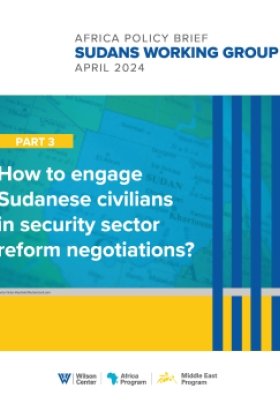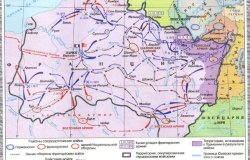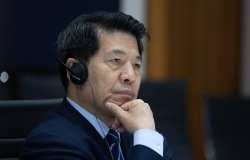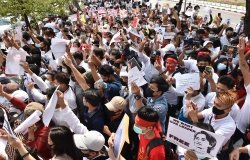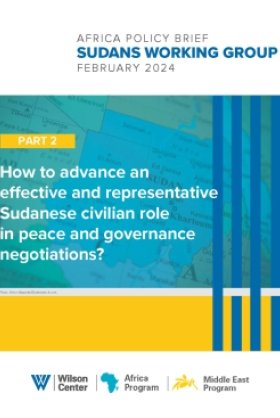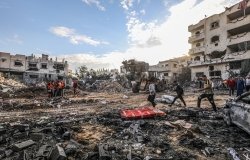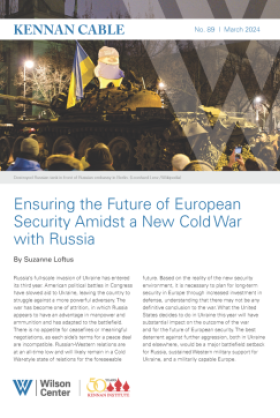The Human Rights Implications of Global Trafficking in Persons
Eric Schwartz, Chief of Staff, United Nations High Commissioner for Human Rights and Former Public Policy Scholar, Woodrow Wilson Center
Overview
Full remarks by Eric Schwartz,
Chief, Executive Office of the High Commissioner for Human Rights
I first want to thank the Wilson Center for hosting this meeting, as well as my dear friend, Dawn Calabia of the UN Information Center in Washington, for her work in pulling it together. One of the joys of my new job at the UN in Geneva is that Dawn and I are, once again, colleagues.
I spent four very happy and productive months here at the Wilson Center back in 2001. As a result of the generosity of Lee Hamilton and Mike Van Dusen, I was able to reflect and write about a number of the humanitarian issues that now inform so much of my work in Geneva. The opportunity to leave government, reflect and write, and then re-enter public service – that is, get back into the fray, but with a bit more smarts and perspective – is an invaluable feature of public life in Washington and New York – and one for which I am enormously grateful.
Before beginning, I probably should say a word about the events of this past August. I have been at the UN's Office of the High Commissioner for Human Rights since mid-July, having traveled to Geneva to run the front office of the organization for the then-High Commissioner, Sergio Vieira de Mello. Of course, the awful event of August 19, the bombing of the UN headquarters in Baghdad, and the killing of the High Commissioner, was a devastating experience in so many ways, and has affected OHCHR profoundly. Among the many who were killed, Sergio Vieira de Mello was a man of vision and leadership who had already infused the organization with a renewed sense of purpose. But, perhaps ironically, Sergio's death has only reaffirmed the importance of moving the institution forward. As I've told many friends and colleagues, the events caused me to think about the quality of adaptability – that while life's events are not all that predictable, one can rely on the fact that important and life-affirming challenges will present themselves to those who are prepared to look. In this case, it is the critical challenge of helping to sustain continuity and a sense of forward movement in an institution which is composed of many highly gifted and committed people, whose challenge will be to do honor to Sergio's legacy in the months and years to come.
Let me now begin by saying a little bit about the Office of the High Commissioner, and then talk about how our work on anti-trafficking fits into our overall mission and provides, I think, a model of effective work of the organization.
As described in our annual report, the mission of the Office of the UN High Commissioner for Human Rights is to protect and promote human rights for all, guided by the UN Charter, the Universal Declaration of Human Rights and subsequent human rights instruments, and the 1993 Vienna Declaration of Human Rights and its program of action. The United States was a driving force behind the creation of this institution; in fact, I well remember collaborating with John Shattuck in the early part of the Clinton Administration, on inserting a reference to the High Commissioner in the Vienna Declaration, when John was Assistant Secretary of State for Democracy, Human Rights and Labor and I was at the National Security Council.
The Office of the High Commissioner aims to ensure the practical implementation of universally recognized human rights norms, and is committed to strengthening the UN human rights program. In addition, the High Commissioner for Human Rights is the official with principal responsibility for UN human rights activities, and also must serve as a spokesperson worldwide for human rights principles – an advocate for those who may be suffering at the hands of abusive governments.
The challenges of the Office are enormous. For one thing, the total annual budget of the office is, give or take few million, about 70 million dollars. And while the Office is part of the UN Secretariat, nearly two-thirds of this budget is raised from donors – less than twenty-five million has come from the UN's regular budget annually. So, given the need, identifying priorities and figuring out how best to leverage limited resources is, in my view, the overwhelming challenge confronting the Office. Second, the High Commissioner is, effectively, given dual and often conflicting responsibilities: of working with governments on capacity-building in the area of human rights, while at the same time, being prepared to speak truth to power – and criticize officials and speak out against abuses. And, finally, the Office of the High Commissioner faces formidable challenges in its effective role as secretariat to expert and/or intergovernmental bodies, like the UN Human Rights Commission. Such intergovernmental institutions have come under criticism in the United States and elsewhere, with critics unfairly attributing to the High Commissioner responsibility for the work of these bodies. At the same time, the High Commissioner and the Office has some ability to influence the procedures of these institutions, and navigating that terrain – that is, determining what can and cannot be done – is a challenge of great proportions.
So, given all those challenges, what should be the message of this institution? Of course, the message is informed by the mandates the institution receives from the General Assembly and other UN bodies. But the mandates do not, by themselves, define the entire mission. I think – and let me emphasize that you are hearing a personal opinion -- that the institution's "deliverable" (to use a Washington term) must be an integrated human rights program that promotes and brings together at least three critical components into coherent whole. First, the organization must provide expert assistance to the traditional human rights institutions, not only the Human Rights Commission, but to the UN treaty bodies established to monitor implementation of key human rights instruments; and to the UN special procedures. And while it will only be governments that drive fundamental reforms in these institutions, the Office of the High Commissioner can play a catalytic role in promoting reforms. I'm convinced this issue was high on Sergio's agenda, and it will be a key question for a new High Commissioner as well. Second, and despite the small size of the institution, we do need a clearly targeted field presence for the purpose of monitoring and capacity-building – to fill critical gaps where other institutions are not present, and also to serve as a laboratory where the norms developed in human rights instruments are given practical application. And, finally, and to get closer to the topic of today's talk, we need to be a leader in anticipating and responding to new conceptual and practical human rights challenges; and in offering practical guidance.
So, when the international community gets together later this year in Geneva on a summit on the World Information Society – and considers the impact of the revolution in information and communications – our office needs to be ensuring that the human rights implications of this exercise – freedom of expression, access to communication tools that might give the poor a meaningful role in the political lives of their societies, the rights to privacy, and related issues – are all considered.
Similarly, when other UN or governments institutions undertake important policy initiatives with human rights implications, we need to be there to inject human rights concerns – for example, by the organization's human rights training program for peacekeepers, or our efforts to implement an important initiative of the Secretary General's reform program designed to promote human rights concerns into all UN operations – an initiative known as "Action 2."
And, of course, I would put into this category the important work the institution is doing on anti-trafficking.
But let me start with a caveat. To be sure, I do have a bit of experience on this issue. When I was at the NSC, it was the December 1996 visit to the White House of a human rights award winner, Julie Su, that prompted the White House to promote the concept of permanent residence in the United States for victims of trafficking who might otherwise feel deterred about coming forward with complaints – for fear of deportation. Similarly, it was during my own tenure at the NSC that my office promoted adoption of the protocol to prevent, suppress and punish trafficking in persons.
But an expert, I am not – in the two cases cited, it was Scott Busby and Wendy Patten, who played critical roles while working in my office at the NSC -- and there are many out in the audience who would be better prepared that I to offer remarks on trafficking. But I will nonetheless plow on for three reasons: first, because I believe that out anti-trafficking efforts offer an example of where OHCHR can play a key role in addressing new human rights challenges; second, because I didn't have complete control of the subject of this presentation; and third, because I figured I might learn something from the discussion we will have after my remarks.
Let me also say that much of what you are about to hear is informed by the advice OHCHR's adviser on trafficking, Jyoti Sanghera. I am deeply indebted to Jyoti for her analysis, advice and assistance as I prepared for this address.
Let me start by way of background to the issue, talk about what my office is doing, and then finish up by suggesting why I think the effort might be a model for other new human rights challenges.
First, the good news.
There is no question that we have seen increased recognition and appreciation of the nature and magnitude of the crime of trafficking in human beings, reflected in some measure by the protocol to prevent, suppress and punish trafficking in persons, especially women and children, supplementing the UN convention against transnational organized crime. That protocol contains a pretty broad definition of the problem – and I can remember a very long conversation with Wendy at the White House during the preparation of the protocol, in which she spent a fair amount of time explaining why language that appeared awkward to me actually made a good deal of sense. As many of you know, that protocol defines trafficking in persons as the "recruitment, transportation, transfer, harbouring or receipt of persons, by means of the threat or use of force or other forms of coercion, of abduction, of fraud, of deception, of the abuse of power or of a position of vulnerability or of the giving or receiving of payments or benefits to achieve the consent of a person having control over another person, for the purpose of exploitation. Exploitation shall include, at a minimum, the exploitation of the prostitution of others or other form of sexual exploitation, forced labour or services, slavery or practices similar to slavery, servitude or the removal of organs."
Second, this protocol supplements a web of protections that exist in other treaties, including the International Covenant on Civil and Political Rights, the International Covenant on Economic, Social and Cultural Rights, the Convention Relating to the Status of Women, the Convention Against Torture, the Convention Against the Elimination of All Forms of Racial Discrimination, the Convention on the Rights of the Child, the Optional Protocol to the Convention on the Right of the Child on the Sale of Child, Child Prostitution and Child Pornography, the Slavery Convention, and the Convention on the Rights of All Migrant Workers and their Families.
Third, these general standards are being supplemented by more specific guidance for governments and international organizations – for example, the important work of my organization, in preparing recommended principles and guidelines on human rights and human trafficking. Those emphasize, first, that though there may be a critical law enforcement dimension, protection of human rights must be at the center of efforts to prevent trafficking; second, that trafficking is more than the organized movement of persons for profit; that it must include deception, force, or coercion, and that precision be used in identifying the problem to ensure that migrants and others aren't further victimized; third, that research, analysis, evaluation and dissemination be regarded as a critical dimension in addressing this issue; fourth, that states adopt adequate legal frameworks to address the problem; fifth, that more creative, effective and victim-sensitive law enforcement strategies be developed; sixth, that states give more and better attention to the protection and support for victims; seventh, that protection efforts be supplemented by a range of preventive measures; eight, that special measures be taken to support child victims; ninth, that states seek to ensure effective legal remedies for victims; tenth, that those involved in peace-keeping and peace-building missions be sensitized to the trafficking issue; and eleventh, that enhanced efforts be made on international cooperation on this issue.
Finally, a number of governments, international organizations and NGOs are doing useful work on this issue, both at the policy level and on the ground.
Of course, enormous challenges remain. The first, perhaps, is the difficulty of obtaining precise statistical date on the scope of the problem. Figures vary due to the difficulty of research in this are and the use of varying methodologies, among other challenges. Secondly, while some governments have made progress, many more have yet to come to grips with the issue and make it a priority. In some cases this is a reflection of the lack of political will, but it also reflects constraints with respect to institutional capacity. Third, even when a government targets traffickers, the lack of a comprehensive national rights-protection strategy will limit the impact of such efforts, as trafficking thrives when other social and economic issues are not addressed. Fourth, in many cases, a developing law enforcement model comes at the expense of sensitivity to the needs of victims, especially in a climate in which governments are cracking down on irregular migration.
So, out of this context, how is OHCHR trying to help?
Our program was initiated in early 1999, and now sits in the Office's Research and Right to Development Branch. The principles which have guided our program development and implementation effort include:
First, an emphasis on legal and policy development, especially at the international and regional levels;
Second, integration of anti-trafficking issues into related areas, including development, migration, labour, conflict, security and gender;
And, finally, an emphasis on OHCHR as a catalyst and partner in the anti-trafficking work of other organizations.
With these goals in mind, some of our recent achievements include --
n the dissemination of the principles and guidelines, which have now been translated into French, Spanish, Arabic, Chinese and Russian;
n the drafting of a legal commentary to the recommended principles and guidelines, to help on policy and legal interventions on the issue;
n publication of a guide to human rights and legislative practices to combat trafficking in persons, especially women and children, in collaboration with other UN organizations;
n publication of frequently asked question on trafficking;
n production of user-friendly versions of the principles and guidelines;
n support of the updating and production of a major report on trafficking in human beings in Southeaster Europe, as an outcome to a join research project with UNICEF and OSCE/ODIHR.
n Preparation of a module on trafficking for training packages on human rights and development for UN field staff;
n And a range of additional activities, including assisting governments in developing national plans of action, technical support for our own and other UN field offices, and involvement with intergovernmental efforts to address this issue.
In 2004, our objectives will be --
n to enhance and ensure the capacity of the High Commissioner to provide policy guidance and leadership on this issue;
n to strengthen the capacity of OHCHR and the UN human rights system to deal with the human rights dimension of trafficking;
n to ensure integration of a human rights perspective into anti-trafficking work;
n and to encourage governments, international organizations, NGOs and others to consider trafficking in their programs.
In 2004, we will also try to supplement our work on protection of victims of trafficking through an emphasis on prevention, by focusing on specific economic and social issues that create vulnerability to trafficking. We will look to embed our program within the context of poverty reduction strategies, irregular migration, sustainable livelihoods, labor exploitation, partnerships with the private sector, and related issues.
I should note that, while we will promote this shift, the entry point of the project will remain trafficking. Thus, for example, our work on migration will largely focus on "informed and safe migration", to undermine the risk of trafficking. Similarly, employment generation will be addressed in the context of job training and affirmative action for those vulnerable persons in out-migration areas. And support for our UN country teams will focus on these and related links.
I should note that when this project was presented to our Policy Review Committee, it was budgeted at about 313,000 dollars, which represented, basically, continuity of effort. Given the importance of this work, and that fact that is was so closely connected to priorities of the former High Commissioner -- and despite the fact that our organization is not in a period of major expansion -- we asked the program manager to come back with a more ambitious project for 2004.
At the same time, our effort will remain focused not on large scale field interventions, but policy and program interventions where we believe we can play a catalytic role: whether that is in the area of legal development, development of doctrine and guidelines, technical support to governments, or efforts to inject these concerns throughout the UN system.
This sort of intervention, I think, is the model that our small yet critical organization should be following. For me, the model of OHCHR should be "the little engine that could" – that could leverage modest resources to make a significant and substantial contribution to human rights in the broader arena.
Thank you for your interest in this event. Please send any feedback or questions to our Events staff.
